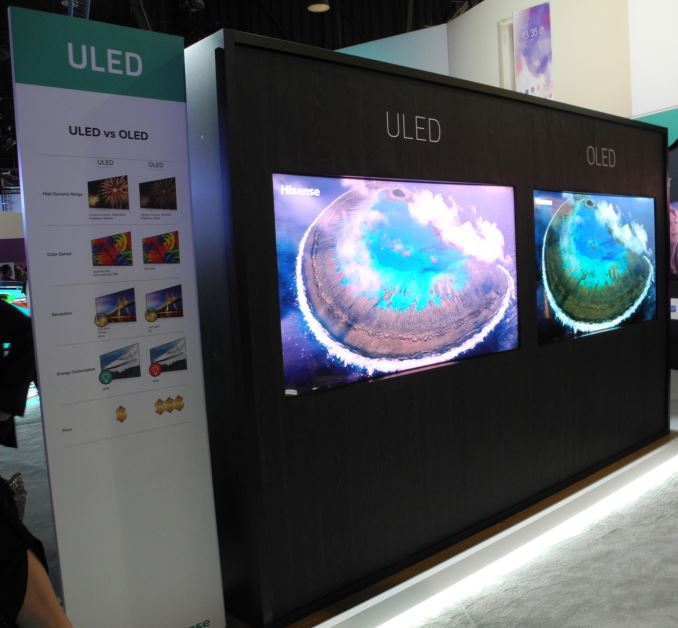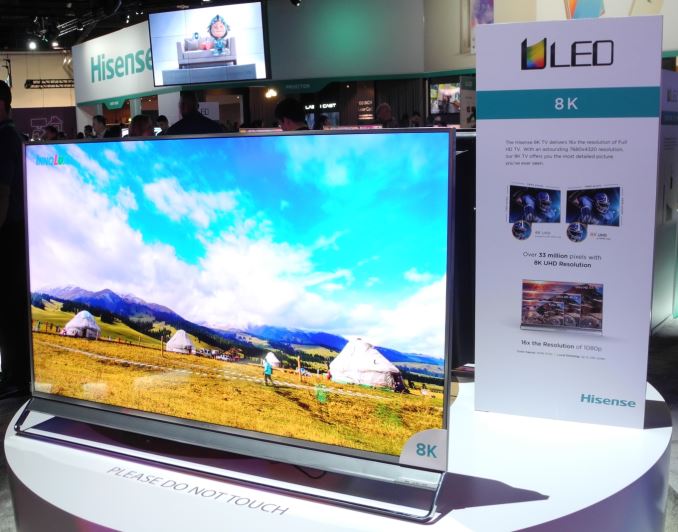Hisense at CES: Affordable and Feature-Packed 4K TVs for HTPCs
by Ganesh T S on January 11, 2016 3:50 AM EST
We usually don't cover televisions in detail here at AnandTech. However, the current flux in the market when it comes to 4K displays for HTPCs made CES 2016 an interesting destination for us to look at what vendors will be offering in the near future. Consumers looking for the best possible picture quality and not concerned about the price have a number of models to choose from in the Smasung SUHDTV series and the Sony XBR series TVs.
Vizio and Hisense 4K TVs are perfect for those on a tight budget. However, a limited budget also means that one can't afford to be an early adopter and be stuck with an outdated television early on. In June 2014, we covered the launch of the Hisense 50H7GB 4K TV. In that article, we covered the minimum features that a 4K HTPC display needed to support in order to not become obsolete within a couple of years. The 50H7GB 50" 4K TV was launched at $600. It supported HDMI 2.0 and HDCP 2.2, with the only disappointing factor being the absence of HDR capabilities. Consumers considering this model obviously have price, and not picture quality, at the top of their purchase factors. In late August 2015, Hisense had launched the H10 series ULED TV with full-array local dimming and quantum dot technologoy for a wider color gamut (the 65" model is currently available for $2500).
At CES 2016, we stopped by Hisense's booth to get an idea of what they had in store for consumers over the rest of the year and what they are working on for future products. The good news is that all the four 4K TV lineups get updated with HDR processing capability - the H7, H8, H9 and H10.
- The new H10 will be similar to the one currently available on Amazon with all the Smart TV and Wi-Fi features, but Hisense hopes to get THX certification for this high-end curved model.
- The H9 (55", $1000, February 2016) gets all the features of the new H10 except that it will not have 3D or quantum dot technology.
- The H8 (50" - $600, 55" - $700, April 2016) is not a curved model. But, Hisense indicates that it will not have the vibrant picture quality of the H9 and H10.
- The H7 (43" - $400, 50" - $550, 55" - $650, 65" - $1300, February 2016) doesn't have the full-array local dimming present in the other models, but carries forward other features from the H8.
It is exciting to see that HDR is making an appearance at mainstream price points. However, wider color gamut is absolutely essential to better appreciate the right 4K content. It might be worthwhile to take a look at the complete specification sheets of the above models before making a purchase decision. Important aspects to track down would be the panel type and panel bitwidth, color gamut coverage and black levels.
Hisense believes that there is a big tussle going on between ULED technology and OLED. To give consumers their perspective, they had the same clip running on a ULED TV as well as an OLED TV side by side in their booth.
To be frank, the OLED TV playback was more pleasing to the eye. However, a side chart indicated that OLEDs have trouble reaching brightness levels that can be achieved via ULED technology. In addition, the quantum dots technology being used in ULED TVs can deliver 106% of the NTSC color gamut, while the best OLEDs can only reach 85% of the NTSC color gamut. While the ULED TV on display was consuming 280W, the equivalent sized OLED TV was consuming 500W. Finally, the OLED TV on display currently costs three times as much as the ULED TV. It would be nice if ULED TVs could further evolve to get some of the more desirable features of OLED TVs - particularly in terms of black levels.
Looking further into the future, Hisense also had a static demo of a 8K model in their booth. Other than the resolution (7680x4320), there was no other information about the television or expected release dates.
As part of their press releases, Hisense also indicated that the Sharp brand is going to be alive and well, and will be around as a premium brand. The N9000, a 70" flat-screen 4K TV with other specifications similar to the H10 series, will come to the market in July for $3000.












18 Comments
View All Comments
Beany2013 - Monday, January 11, 2016 - link
Damn, those prices are very tempting as a large display replacement. Shame I'm currently not working, eh?I'd sort of ignored 4k up till now, but it looks like displays are getting manufactured at a rate that's bringing price down to the level the rest of us can justify. I'm sure they'll get cheaper, but under £500 (the 40" current version is available on Amazon Uk for £300) is really not bad, given that only a couple of years ago I paid £200 for a 42" 1080p TV that, er, I almost never use...
Murloc - Tuesday, January 12, 2016 - link
why buy a 4k TV since you never use the full hd TV either?CSMR - Monday, January 11, 2016 - link
It would be good to know if any of these tvs support standby mode when the htpc tells the screen to go into standby.jann5s - Monday, January 11, 2016 - link
what is uled?atcronin - Monday, January 11, 2016 - link
and thats the beauty of marketing.nathanddrews - Monday, January 11, 2016 - link
ULED = Snake oil marketing, nothing more. It's a Quantum Dot Film on a FALD backlight, nothing more. I like HiSense, they offer some decent products for cheap, but this is just pure PR."However, a side chart indicated that OLEDs have trouble reaching brightness levels that can be achieved via ULED technology. In addition, the quantum dots technology being used in ULED TVs can deliver 106% of the NTSC color gamut, while the best OLEDs can only reach 85% of the NTSC color gamut."
Quoting the HiSense charts taped to the TV?
For starters, when calibrated properly, the peak brightness of the display is less important, even with HDR. What matters more, especially with HDR content, is the static contrast ratio - which OLED destroys even the best local-dimming LCD. Even with ABL holding it back, OLED is impossible to beat in this area. Compared side-by-side, an LCD will appear brighter than an OLED, but it will also appear more washed out.
As for NTSC color reproduction, I assume they mean CIE 1953. If so, many current 4K TVs are over 100%, including every OLED I've seen reviewed. I have no idea where they are getting the 85% figure. The inherent problem with that measurement when used as marketing is that one need only reach the same color space area (as a factor of CIE 1931) - but it could be shifted red, green, or blue, and have a bizarre white point - it says nothing about color accuracy. On top of that, there's nothing too impressive about that since 100% NTSC is only ~60% of Rec. 2020, which is the future (present) of 4K and HDR content. Likewise, all current 1080p content is Rec. 709, which is even narrower than NTSC. If HiSense (and LG, Samsung, etc.) wants to impress, they need to publish Rec. 2020 numbers and DCI-P3 numbers.
I think all but two high-end commercial laser projectors and a couple of OLED professional video monitors are currently capable of getting even close to 100% Rec. 2020. The latest Ultra HD Premium spec from the UHD Alliance requires displays to reach 90% of DCI-P3 in addition for static contrast ratios and specific peak brightness and minimum black levels. All of LG's OLEDs pass and only the best LCDs pass. The Ultra HD Premium badge is the target to hit for 2016.
nathanddrews - Monday, January 11, 2016 - link
Dat 8K tho...Dug - Monday, January 11, 2016 - link
Thanks for pointing all of this out.ganeshts - Monday, January 11, 2016 - link
I specifically mention "a side chart indicated" - I didn't say that I agree with those :)FWIW, I still prefer the OLED - I don't like cranking up the brightness in my TVs, and the OLED is definitely more pleasing to the eye.
The problem is mainly the cost and the power consumption for the OLED TVs. I actually don't agree with the other marketing points posted by Hisense.
nathanddrews - Tuesday, January 12, 2016 - link
I didn't intend my comment to be accusatory, just inquisitive. OLED is indeed the most impressive display tech I've seen in a long time, but they just need to sort a couple issues (screen door effect is my biggest pet peeve) in order to really go mainstream. Obviously price will have to come down a lot as well, but that's not going to happen as long as LG can lord it over LCD as a premium product.